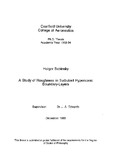JavaScript is disabled for your browser. Some features of this site may not work without it.
| dc.contributor.advisor | Edwards, John A. | |
| dc.contributor.author | Babinsky, Holger | |
| dc.date.accessioned | 2012-09-20T13:40:04Z | |
| dc.date.available | 2012-09-20T13:40:04Z | |
| dc.date.issued | 1993-12 | |
| dc.identifier.uri | http://dspace.lib.cranfield.ac.uk/handle/1826/7586 | |
| dc.description.abstract | The influence of large scale regular roughness on a Mach 5 turbulent boundary layer and a compression corner was investigated on axisymmetric wind tunnel models. Three types of roughness were examined; a series of square cavities at two different sizes and a 45 degree sawtooth. Typical sizes ranged from 50% to 100% of an undisturbed boundary layer thickness. The roughness was limited to a short region followed by a smooth surface. Compression corners were formed by 15° and 20° flares located downstream of the roughness. The flow in the wind tunnel was investigated in detail to obtain knowledge on operating conditions and flow quality. Liquid crystal thermography was developed for routine use in hypersonic blow-down wind tunnels with superior spatial resolution and experimental uncertainties in the range of traditional techniques. The effect on flow parameters downstream of the last roughness element were 7, found to differ significantly for the different quantities. Velocity profiles were found i, to be less full and skin friction was found to be reduced for all streamwise "~ distances. Surface heat transfer was increased in a short region limited to 1.5 boundary layer thicknesses behind the roughness whereas surface pressure was not affected. Sawtooth shaped roughness was found to cause a stronger j disturbance than square cavities of twice the size. Little influence of the roughness was noted on the flow over the compression corner. The flow over the 20° compression corner showed an increase in upstream influence for the sawtooth shaped roughness as well as the larger cavities. Surface pressure measurements did not indicate a separation in any case. Heat transfer measurements revealed a peak located approximately 0.25 boundary layer thicknesses behind the corner. No such feature was found in the surface pressure distributions. It is suggested that a small scale separation is located very close to the corner causing the peak in heat transfer at reattachment without any effect on surface pressures. The existence of such a separation has been confirmed by surface flow visualisations for both flares. | en_UK |
| dc.language.iso | en | en_UK |
| dc.publisher | Cranfield University | en_UK |
| dc.title | A study of roughness in turbulent hypersonic boundary-layers | en_UK |
| dc.type | Thesis or dissertation | en_UK |
| dc.type.qualificationlevel | Doctoral | en_UK |
| dc.type.qualificationname | PhD | en_UK |
